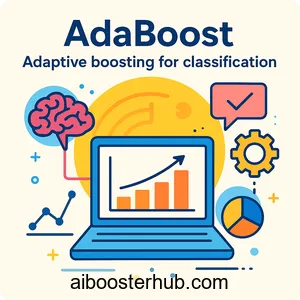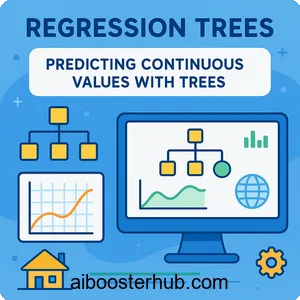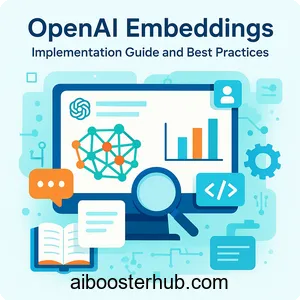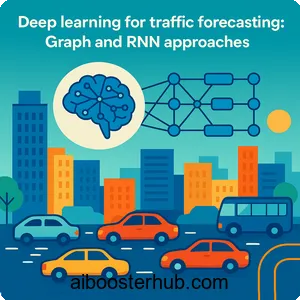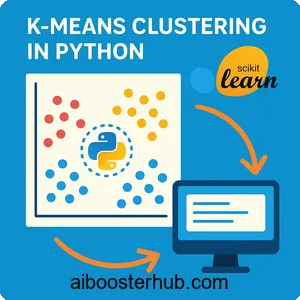LightGBM: Efficient gradient boosting decision trees
Machine learning practitioners constantly seek algorithms that deliver both exceptional accuracy and computational efficiency. LightGBM, a highly efficient gradient boosting decision tree framework, has emerged as one of the most powerful tools in the modern AI toolkit. Developed by Microsoft, this gradient boosting machine (GBM) implementation revolutionizes how we approach large-scale machine learning problems by introducing novel techniques that dramatically reduce training time while maintaining, or even improving, model performance.
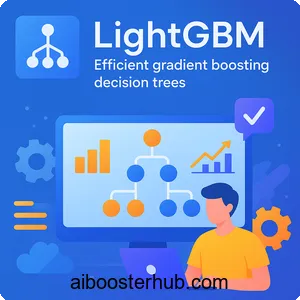
In this comprehensive guide, we’ll explore what makes LightGBM stand out from other boosting algorithms, dive deep into its technical innovations, and demonstrate how to leverage its capabilities through practical Python examples. Whether you’re comparing lightgbm vs xgboost or seeking to understand the intricacies of gradient boosting decision tree architectures, this article will equip you with the knowledge to harness LightGBM’s full potential.
Content
Toggle1. Understanding gradient boosting and GBDT fundamentals
Before diving into LightGBM’s specific innovations, it’s essential to understand the foundation upon which it’s built: gradient boosting and gradient boosting decision trees.
What is gradient boosting?
Gradient boosting is an ensemble learning technique that builds models sequentially, where each new model attempts to correct the errors made by the previous ones. The core idea is elegantly simple yet powerful: combine multiple weak learners (typically decision trees) to create a strong predictive model.
The mathematical foundation of gradient boosting involves minimizing a loss function ( L(y, F(x)) ) by iteratively adding new models. At each iteration ( m ), we fit a new model ( h_m(x) ) to the negative gradient of the loss function:
$$ F_m(x) = F_{m-1}(x) + \nu \cdot h_m(x) $$
where \( \nu \) is the learning rate that controls the contribution of each tree. The negative gradient serves as a pseudo-residual that guides the training process:
$$ r_{im} = -\left[\frac{\partial L(y_i, F(x_i))}{\partial F(x_i)}\right]{F(x)=F{m-1}(x)} $$
GBDT architecture
A gradient boosting decision tree (GBDT) uses decision trees as the base learners in this ensemble. Each tree in the sequence learns to predict the residual errors of the cumulative ensemble. This iterative refinement process allows GBDT to capture complex patterns in data that would be impossible for a single tree to learn.
Traditional GBDT implementations follow a level-wise (depth-wise) growth strategy, where all nodes at the same depth are split simultaneously. While this approach ensures balanced trees, it can be computationally expensive and may not always lead to optimal splits.
2. What makes LightGBM highly efficient
LightGBM introduces several groundbreaking optimizations that make it a highly efficient gradient boosting decision tree framework. These innovations address the computational bottlenecks found in traditional GBDT implementations.
Leaf-wise growth strategy
Perhaps the most significant innovation in LightGBM is its leaf-wise (best-first) tree growth strategy. Unlike traditional level-wise growth, leaf-wise growth selects the leaf with the maximum delta loss to grow. This approach can lead to much deeper trees with fewer iterations, resulting in better accuracy and faster training.
The leaf-wise growth algorithm prioritizes splits that provide the greatest reduction in loss:
$$ \text{Gain} = \frac{1}{2}\left[\frac{G_L^2}{H_L + \lambda} + \frac{G_R^2}{H_R + \lambda} – \frac{(G_L + G_R)^2}{H_L + H_R + \lambda}\right] – \gamma $$
where \( G_L \) and \( G_R \) are the sum of gradients for left and right children, \( H_L \) and \( H_R \) are the sum of hessians, \( \lambda \) is the L2 regularization term, and \( \gamma \) is the minimum loss reduction required to make a split.
Histogram-based algorithm
LightGBM employs a histogram-based algorithm that buckets continuous features into discrete bins. Instead of finding split points by scanning through all possible feature values, LightGBM builds histograms and uses these to find optimal splits. This reduces the complexity from \( O(data \times features) \) to \( O(bins \times features) \), dramatically speeding up training.
Gradient-based One-Side Sampling (GOSS)
GOSS is an innovative technique that focuses on data instances with larger gradients. The insight is that instances with small gradients are already well-trained, so we can safely down-sample them without significantly impacting accuracy. GOSS keeps all instances with large gradients and randomly samples instances with small gradients, reducing the number of data instances while maintaining accuracy.
Exclusive Feature Bundling (EFB)
In high-dimensional datasets, many features are mutually exclusive (rarely take non-zero values simultaneously). EFB bundles these mutually exclusive features together, reducing the number of features and further accelerating training. This is particularly effective for sparse datasets.
3. Getting started with LightGBM python
Let’s explore how to implement LightGBM in Python through practical examples. We’ll start with basic usage and progress to more advanced scenarios.
Installation and basic setup
First, install LightGBM using pip:
# Install LightGBM
# pip install lightgbm
import lightgbm as lgb
import numpy as np
import pandas as pd
from sklearn.model_selection import train_test_split
from sklearn.metrics import accuracy_score, mean_squared_error
from sklearn.datasets import load_breast_cancer, load_diabetes
Binary classification example
Let’s build a binary classifier using LightGBM:
# Load dataset
data = load_breast_cancer()
X, y = data.data, data.target
# Split the data
X_train, X_test, y_train, y_test = train_test_split(
X, y, test_size=0.2, random_state=42
)
# Create LightGBM dataset
train_data = lgb.Dataset(X_train, label=y_train)
test_data = lgb.Dataset(X_test, label=y_test, reference=train_data)
# Set parameters
params = {
'objective': 'binary',
'metric': 'binary_logloss',
'boosting_type': 'gbdt',
'num_leaves': 31,
'learning_rate': 0.05,
'feature_fraction': 0.9,
'bagging_fraction': 0.8,
'bagging_freq': 5,
'verbose': 0
}
# Train the model
num_round = 100
bst = lgb.train(
params,
train_data,
num_round,
valid_sets=[test_data],
callbacks=[lgb.early_stopping(stopping_rounds=10)]
)
# Make predictions
y_pred = bst.predict(X_test, num_iteration=bst.best_iteration)
y_pred_binary = [1 if x > 0.5 else 0 for x in y_pred]
# Evaluate
accuracy = accuracy_score(y_test, y_pred_binary)
print(f'Accuracy: {accuracy:.4f}')
Regression example
LightGBM also excels at regression tasks:
# Load diabetes dataset
diabetes = load_diabetes()
X, y = diabetes.data, diabetes.target
# Split the data
X_train, X_test, y_train, y_test = train_test_split(
X, y, test_size=0.2, random_state=42
)
# Create dataset
train_data = lgb.Dataset(X_train, label=y_train)
test_data = lgb.Dataset(X_test, label=y_test, reference=train_data)
# Parameters for regression
params = {
'objective': 'regression',
'metric': 'rmse',
'boosting_type': 'gbdt',
'num_leaves': 31,
'learning_rate': 0.05,
'feature_fraction': 0.9,
'verbose': 0
}
# Train
bst = lgb.train(
params,
train_data,
num_boost_round=200,
valid_sets=[test_data],
callbacks=[lgb.early_stopping(stopping_rounds=20)]
)
# Predict and evaluate
y_pred = bst.predict(X_test, num_iteration=bst.best_iteration)
rmse = np.sqrt(mean_squared_error(y_test, y_pred))
print(f'RMSE: {rmse:.4f}')
Using scikit-learn API
LightGBM provides a scikit-learn compatible API for seamless integration:
from lightgbm import LGBMClassifier, LGBMRegressor
# Classification
clf = LGBMClassifier(
num_leaves=31,
learning_rate=0.05,
n_estimators=100,
random_state=42
)
clf.fit(X_train, y_train)
y_pred = clf.predict(X_test)
accuracy = accuracy_score(y_test, y_pred)
print(f'Sklearn API Accuracy: {accuracy:.4f}')
# Feature importance
feature_importance = pd.DataFrame({
'feature': data.feature_names,
'importance': clf.feature_importances_
}).sort_values('importance', ascending=False)
print("\nTop 10 Most Important Features:")
print(feature_importance.head(10))
4. LightGBM vs XGBoost: A comprehensive comparison
One of the most common questions in the gradient boosting community is: how does lightgbm compare to xgboost? Both are powerful gradient boosting frameworks, but they differ in their approaches and optimizations.
Speed and memory efficiency
LightGBM generally trains faster than XGBoost, especially on large datasets. The histogram-based algorithm and leaf-wise growth strategy give LightGBM a significant speed advantage. In practical benchmarks, LightGBM can be 10-20 times faster on large datasets while using less memory.
Here’s a performance comparison example:
import time
import xgboost as xgb
# Generate larger synthetic dataset
from sklearn.datasets import make_classification
X, y = make_classification(
n_samples=100000,
n_features=50,
n_informative=30,
n_redundant=10,
random_state=42
)
X_train, X_test, y_train, y_test = train_test_split(
X, y, test_size=0.2, random_state=42
)
# LightGBM training
start_time = time.time()
lgb_train = lgb.Dataset(X_train, label=y_train)
lgb_params = {
'objective': 'binary',
'metric': 'binary_logloss',
'num_leaves': 31,
'learning_rate': 0.05,
'verbose': -1
}
lgb_model = lgb.train(lgb_params, lgb_train, num_boost_round=100)
lgb_time = time.time() - start_time
# XGBoost training
start_time = time.time()
dtrain = xgb.DMatrix(X_train, label=y_train)
xgb_params = {
'objective': 'binary:logistic',
'eval_metric': 'logloss',
'max_depth': 6,
'eta': 0.05,
'tree_method': 'hist'
}
xgb_model = xgb.train(xgb_params, dtrain, num_boost_round=100)
xgb_time = time.time() - start_time
print(f'LightGBM training time: {lgb_time:.2f} seconds')
print(f'XGBoost training time: {xgb_time:.2f} seconds')
print(f'Speedup: {xgb_time/lgb_time:.2f}x')
Tree growth strategy
The fundamental difference lies in tree growth:
- XGBoost: Uses level-wise (depth-wise) growth, splitting all nodes at the same level
- LightGBM: Uses leaf-wise growth, splitting the leaf with maximum delta loss
Leaf-wise growth can achieve better accuracy with fewer trees but may overfit if not properly regularized. The max_depth parameter becomes crucial in LightGBM to control overfitting.
Handling categorical features
LightGBM has native support for categorical features, automatically handling them optimally without requiring one-hot encoding:
# LightGBM with categorical features
df = pd.DataFrame({
'feature1': np.random.randn(1000),
'feature2': np.random.randn(1000),
'category': np.random.choice(['A', 'B', 'C', 'D'], 1000),
'target': np.random.randint(0, 2, 1000)
})
# Convert categorical column
df['category'] = df['category'].astype('category')
X = df[['feature1', 'feature2', 'category']]
y = df['target']
# LightGBM automatically handles categorical features
train_data = lgb.Dataset(X, label=y, categorical_feature=['category'])
params = {
'objective': 'binary',
'metric': 'binary_logloss',
'verbose': -1
}
model = lgb.train(params, train_data, num_boost_round=50)
XGBoost requires manual preprocessing of categorical features through encoding techniques.
When to choose which?
Choose LightGBM when:
- Working with large datasets (>10K rows)
- Speed and memory efficiency are priorities
- You have categorical features
- Dataset is sparse
Choose XGBoost when:
- Dataset is small to medium-sized
- You need more conservative tree growth
- Maximum stability is required
- You’re working with a well-established production pipeline
5. Advanced techniques and parameter tuning
Mastering LightGBM requires understanding its extensive parameter set and advanced features.
Key parameters for optimal performance
# Comprehensive parameter configuration
advanced_params = {
# Learning control
'objective': 'binary',
'metric': 'auc',
'boosting_type': 'gbdt', # or 'dart', 'goss', 'rf'
'learning_rate': 0.05,
'num_leaves': 31,
'max_depth': -1, # no limit
# Tree structure
'min_data_in_leaf': 20,
'min_sum_hessian_in_leaf': 1e-3,
'min_gain_to_split': 0.0,
# Feature sampling
'feature_fraction': 0.8,
'feature_fraction_bynode': 0.8,
# Bagging
'bagging_fraction': 0.8,
'bagging_freq': 5,
# Regularization
'lambda_l1': 0.0,
'lambda_l2': 0.0,
'min_split_gain': 0.0,
'max_bin': 255,
# Speed optimization
'num_threads': -1,
'force_col_wise': False,
'force_row_wise': False,
# GOSS parameters
'top_rate': 0.2,
'other_rate': 0.1,
# Categorical features
'cat_smooth': 10,
'cat_l2': 10,
# Output
'verbose': -1,
'seed': 42
}
Cross-validation and hyperparameter tuning
Implementing proper cross-validation is crucial:
from sklearn.model_selection import cross_val_score, GridSearchCV
# Using LightGBM's built-in CV
cv_results = lgb.cv(
params,
train_data,
num_boost_round=1000,
nfold=5,
stratified=True,
shuffle=True,
callbacks=[lgb.early_stopping(stopping_rounds=50)]
)
print(f'Best number of iterations: {len(cv_results["valid auc-mean"])}')
print(f'Best CV score: {max(cv_results["valid auc-mean"]):.4f}')
# Grid search with sklearn API
param_grid = {
'num_leaves': [15, 31, 63],
'learning_rate': [0.01, 0.05, 0.1],
'n_estimators': [50, 100, 200],
'max_depth': [3, 5, 7, -1],
'min_child_samples': [10, 20, 30]
}
lgb_estimator = LGBMClassifier(random_state=42, verbose=-1)
grid_search = GridSearchCV(
estimator=lgb_estimator,
param_grid=param_grid,
cv=3,
scoring='roc_auc',
n_jobs=-1,
verbose=1
)
grid_search.fit(X_train, y_train)
print(f'\nBest parameters: {grid_search.best_params_}')
print(f'Best CV score: {grid_search.best_score_:.4f}')
Handling imbalanced datasets
LightGBM provides several strategies for imbalanced classification:
# Method 1: Using scale_pos_weight
pos_weight = len(y_train[y_train == 0]) / len(y_train[y_train == 1])
params_imbalanced = {
'objective': 'binary',
'metric': 'auc',
'scale_pos_weight': pos_weight,
'is_unbalance': True, # Method 2: Alternative approach
'verbose': -1
}
# Method 3: Custom class weights
class_weights = {0: 1.0, 1: 5.0}
sample_weights = np.array([class_weights[label] for label in y_train])
train_data_weighted = lgb.Dataset(
X_train,
label=y_train,
weight=sample_weights
)
model_weighted = lgb.train(
params,
train_data_weighted,
num_boost_round=100
)
6. Real-world applications and best practices
LightGBM has proven its worth across numerous domains and real-world scenarios. Let’s explore practical applications and best practices.
Feature engineering for LightGBM
# Creating interaction features
def create_features(df):
df_enhanced = df.copy()
# Polynomial features
df_enhanced['feature1_squared'] = df['feature1'] ** 2
df_enhanced['feature1_feature2'] = df['feature1'] * df['feature2']
# Binning continuous features
df_enhanced['feature1_binned'] = pd.cut(
df['feature1'],
bins=5,
labels=False
).astype('category')
# Statistical features
numeric_cols = df.select_dtypes(include=[np.number]).columns
df_enhanced['row_mean'] = df[numeric_cols].mean(axis=1)
df_enhanced['row_std'] = df[numeric_cols].std(axis=1)
return df_enhanced
# Feature selection using LightGBM
def select_features(X, y, threshold=0.01):
model = LGBMClassifier(n_estimators=100, random_state=42)
model.fit(X, y)
feature_importance = pd.DataFrame({
'feature': X.columns,
'importance': model.feature_importances_
})
selected_features = feature_importance[
feature_importance['importance'] > threshold
]['feature'].tolist()
return selected_features, feature_importance
Model interpretation and explainability
Understanding model predictions is crucial:
import shap
# Train a model
model = LGBMClassifier(n_estimators=100, random_state=42)
model.fit(X_train, y_train)
# SHAP analysis
explainer = shap.TreeExplainer(model)
shap_values = explainer.shap_values(X_test)
# Feature importance plot
# shap.summary_plot(shap_values, X_test, feature_names=data.feature_names)
# Single prediction explanation
sample_idx = 0
# shap.force_plot(
# explainer.expected_value[1],
# shap_values[1][sample_idx],
# X_test[sample_idx],
# feature_names=data.feature_names
# )
# Calculate mean absolute SHAP values
shap_importance = pd.DataFrame({
'feature': data.feature_names,
'shap_importance': np.abs(shap_values[1]).mean(axis=0)
}).sort_values('shap_importance', ascending=False)
print("SHAP-based Feature Importance:")
print(shap_importance.head(10))
Production deployment considerations
When deploying LightGBM models to production:
# Save and load models
model.booster_.save_model('lightgbm_model.txt')
loaded_model = lgb.Booster(model_file='lightgbm_model.txt')
# Convert to sklearn format for compatibility
import joblib
joblib.dump(model, 'lightgbm_sklearn.pkl')
loaded_sklearn_model = joblib.load('lightgbm_sklearn.pkl')
# Efficient batch prediction
def batch_predict(model, data, batch_size=1000):
predictions = []
for i in range(0, len(data), batch_size):
batch = data[i:i+batch_size]
batch_pred = model.predict(batch)
predictions.extend(batch_pred)
return np.array(predictions)
# Monitoring model performance
def evaluate_model_performance(model, X, y):
predictions = model.predict(X)
from sklearn.metrics import (
accuracy_score, precision_score,
recall_score, f1_score, roc_auc_score
)
metrics = {
'accuracy': accuracy_score(y, predictions),
'precision': precision_score(y, predictions),
'recall': recall_score(y, predictions),
'f1': f1_score(y, predictions),
'auc': roc_auc_score(y, model.predict_proba(X)[:, 1])
}
return metrics
Common pitfalls and how to avoid them
- Overfitting with leaf-wise growth: Always set
max_depthand use proper regularization - Ignoring categorical features: Use LightGBM’s native categorical support
- Not tuning
num_leaves: This parameter significantly impacts model complexity - Insufficient data for leaf-wise growth: Ensure adequate
min_data_in_leaf - Memory issues: Use
max_binto control histogram size for large datasets
# Preventing overfitting
regularized_params = {
'objective': 'binary',
'max_depth': 7, # Limit tree depth
'num_leaves': 31,
'min_data_in_leaf': 20, # Minimum samples per leaf
'lambda_l1': 0.1, # L1 regularization
'lambda_l2': 0.1, # L2 regularization
'min_gain_to_split': 0.01, # Minimum gain to split
'feature_fraction': 0.8, # Feature sampling
'bagging_fraction': 0.8, # Data sampling
'bagging_freq': 5,
'learning_rate': 0.05, # Lower learning rate
'verbose': -1
}
7. Conclusion
LightGBM represents a significant advancement in gradient boosting technology, offering a highly efficient gradient boosting decision tree framework that excels in both speed and accuracy. Its innovative approaches—including leaf-wise growth, histogram-based algorithms, GOSS, and EFB—make it an ideal choice for modern machine learning applications, particularly when dealing with large-scale datasets.
Throughout this guide, we’ve explored the theoretical foundations of gradient boosting, examined what makes LightGBM unique, compared it with XGBoost, and demonstrated practical implementation strategies using lightgbm python. Whether you’re building classification or regression models, LightGBM provides the tools and efficiency needed to tackle complex AI challenges. By understanding its parameters, applying proper tuning techniques, and following best practices, you can leverage LightGBM to build high-performance models that deliver exceptional results in production environments.


